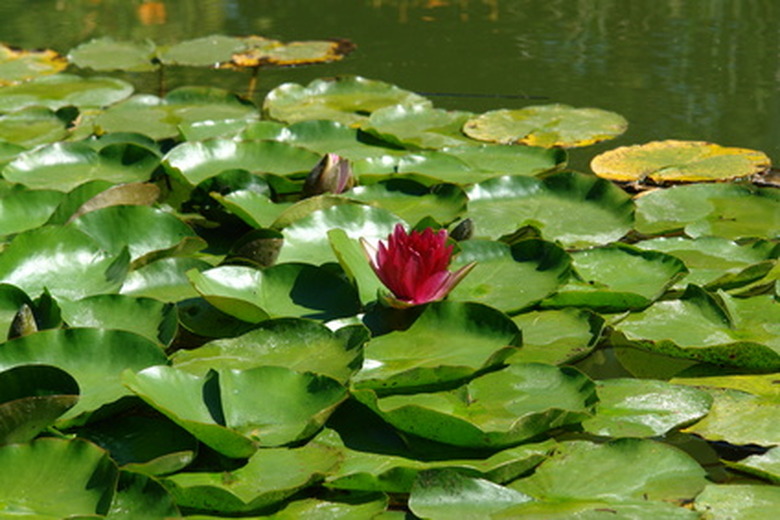Disease In Water Lilies
Water lilies are showy, fragrant water flowers that gardeners plant in ponds for a decorative touch. Although considered hardy and naturally-resistant to most pests and diseases that damage terrestrial flowering plants, few varieties of water lilies are susceptible to diseases that cause severe damage. Knowledge of the different diseases equips the gardener to diagnose their plants' ailments appropriately and restore the floating flowers back to health.
Disease Types
According to online retailer Pond Supply, the most common fungal diseases water lilies are susceptible to are crown rot, black rot and leaf spot.
Identification of Rot
Crown rot causes the leaves and stems of water lilies to turn yellow before breaking away or separating from the crown. The article "How to Grow: Waterlilies," published in "The Daily Telegraph" in 2008, calls this disease highly contagious. Susceptible cultivars include 'Gloriosa,' 'Attraction,' 'Alba,' 'Paul Hariot,' 'Chrysantha,' 'Chromatella' and 'Comanche.'
- Water lilies are showy, fragrant water flowers that gardeners plant in ponds for a decorative touch.
- Although considered hardy and naturally-resistant to most pests and diseases that damage terrestrial flowering plants, few varieties of water lilies are susceptible to diseases that cause severe damage.
Black rot causes the otherwise white roots to turn black and the entire plant emits a foul odor. Water lily leaf spot is another fungal disease that causes dark patches, blotches or spots on the upper surface of leaves. Infected leaves turn brown, curl up and dry.
Quarantine
The "Daily Telegraph" article states that crown rot on water lilies can be treated through quarantine. This is best done when symptoms of the disease first appear, because severely infested plants cannot be restored back to health and should be immediately discarded to prevent spread. To successfully execute this procedure, carefully dig the infected plant and remove diseased or damaged roots or leaves. Place healthy rhizomes under running water to remove any attached debris or traces of the fungal spores, and quarantine in a holding-tub until you are sure they are disease-free.
- Black rot causes the otherwise white roots to turn black and the entire plant emits a foul odor.
- This is best done when symptoms of the disease first appear, because severely infested plants cannot be restored back to health and should be immediately discarded to prevent spread.
Control
Plants heavily infected with crown rot and root rot, or those that could not be restored back after quarantine, need immediate removal to prevent the disease from spreading to surrounding or nearby plants. Discard the plant in a knotted garbage bag. Inspect the foliage of surrounding or nearby plants for symptoms of the disease as well.
If your plants are affected by water lily leaf spot, carefully remove only spotted leaves damaged by leaf spot. If the infection has spread to cover more than half the plant, removal is the best means of control.
Prevention
Thoroughly check the tuberous root and leaves for symptoms of crown rot and leaf spot before purchasing water lilies. Left unchecked, a single infected water lily plant can damage the entire bunch that surrounds it. Remove plant debris surrounding water lilies and divide the plants when the roots outgrow the container or the flowers overcrowd at the top.
- Plants heavily infected with crown rot and root rot, or those that could not be restored back after quarantine, need immediate removal to prevent the disease from spreading to surrounding or nearby plants.
- Remove plant debris surrounding water lilies and divide the plants when the roots outgrow the container or the flowers overcrowd at the top.
References
- Pond Supply: Tropical Water Lilies and Disease
- Pond Expert: Plant Problems
- Pond Trade Magazine: Water Garden Pests and Water Lily Diseases
- "The Daily Telegraph": How to Grow: Waterlilies
- "Complete Guide to Water Garden Plants"; Helen Nash, Steve Stroupe and Perry Slocam; 2003
